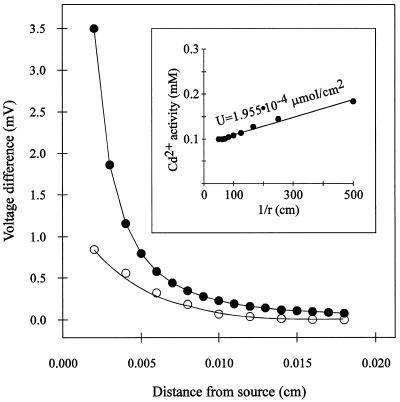Figure 5.
Theoretical (○) and experimental (•) measurements of a Cd2+ gradient as a function of distance from the artificial Cd2+ gradient source. Theoretical values were calculated according to the following equation: ΔV = S([−UΔr]/[Cbr2 + Ur])/2.3, where ΔV is the change in millivolts over the vibration excursion, S is the slope of the electrode, r is the distance from the source, Δr is the amplitude of vibration, Cb is the background activity of Cd2+, and U is an empirical constant. Experimental measurements were made by vibrating the electrode through a 10-μm amplitude at different distances from the Cd2+ source. Inset, Calculation of the empirical constant, U. Static measurements were made at a series of distances from the source and then the millivolt outputs were converted to activity values. A plot of these activity (C) values versus the inverse of the distance from the Cd2+ source (1/r) yields a line with a slope of U, according to the equation: C = Cb + U/r, where Cb is the background activity of Cd2+ (0.09 mm), and U (in micromoles per square centimeter) defines the diffusion characteristics of the gradient source (r2=0.992).

